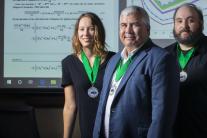Wildlife recovery modeling equals international nod for math faculty
Fri, 07/12/2019 - 8:35amCollege of Sciences dean Azmy Ackleh and mathematics professors Ross Chiquet and Amy Veprauskas have earned international recognition for creating a mathematical model to determine how quickly wildlife can recover following natural disasters.
Ackleh, Chiquet and Veprauskas are recipients of the Rollie Lamberson Research Award. The Resource Modeling Association presents the award.
The team received the award during the association’s conference in May in Montreal for an academic journal article they wrote with two other collaborators. In it, the authors suggested a mathematical framework wildlife and environmental agencies can use to decide if animal populations have had sufficient time to recover after ecological disasters. That determination can enable officials to decide how long conservation efforts – limits on hunting, fishing and seafood harvesting, for example – should continue, the authors wrote.
Sharing the Lamberson prize are Dr. Tingting Tang, a University graduate who is now a postdoctoral scholar in the Department of Applied and Computational Mathematics, University of Notre Dame; and Dr. Hal Caswell, a biologist and emeritus research scholar at Woods Hole Oceanographic Institution, Massachusetts.
Mathematical models replicate real-life situations, and use equations and data to predict future behavior.
The prize-winning article complements other research at the University examining the impact of the Deepwater Horizon oil spill. In April 2010, the wellhead on the rig exploded. Millions of barrels of crude streamed into the Gulf of Mexico before the well was capped three months later.
Shortly after, UL Lafayette researchers, including Ackleh and physics professor Dr. Natalia Sidorovskaia, began studying how the disaster affected sperm and beaked whales that live in the Gulf.
They used underwater acoustical devices to listen to and record the mammals as they communicated in clicks, whistles and other sounds. The noises enabled researchers to determine how the oil spill had affected whale populations.
A $5.9 million grant from the Gulf of Mexico Research Initiative that researchers received in 2014 funded the study as part of the Littoral Acoustic Demonstration Center-Gulf Ecological Monitoring and Modeling consortium project.
“GoMRI’s support has enabled University researchers to examine the numerous effects the oil spill had on the Gulf and its inhabitants for the past five years, and it continues to do so. We are very grateful,” Ackleh said.
The acoustic data provided short-term information on the spill’s effect on the whales, while the model the article presented “provides a means of studying possible long-term impacts,” he added. “This research highlights the fact that mathematical models can provide powerful insights into biological problems even when little data is available.”
The article suggests that to predict when a population will reach pre-disaster levels, it’s key to estimate the number of adult animals in a population. “A population with more adults is able to recover faster because adults are capable of contributing to population numbers through reproduction quicker than juveniles,” Ackleh explained.
Another factor to consider: how the magnitude of the disaster translates to reductions in survival rates of individuals. That’s more important to the long-term recovery of the population than the duration of the crisis.
The loss of life means there are fewer adults, so that suppresses the population’s recovery for a longer period, Ackleh said. He added that agencies should develop strategies to quickly mitigate a disaster’s impact. That’ll help populations bounce back faster.
Though the authors used data about Gulf sperm whales and the Deepwater Horizon spill for their study, the model they produced can be applied to other animals and other crises as well, Ackleh said. “This is a lesson learned for future disasters.”
The article appeared in the February 2019 issue of Natural Resource Modeling, a peer-reviewed journal. Read it here.
The Rollie Lamberson Research Award is named for a retired professor of mathematics at Humboldt State University in California. The Resource Modeling Association presented the inaugural award in 2016.
The association includes researchers from around the world in the fields of mathematical modeling, natural resources management and environmental science. It was founded in 1980.
Photo caption: From left, Dr. Amy Veprauskas, Dr. Azmy S. Ackleh and Dr. Ross Chiquet, recipients of the Rollie Lamberson Research Award. (Photo credit: Doug Dugas / University of Louisiana at Lafayette)

